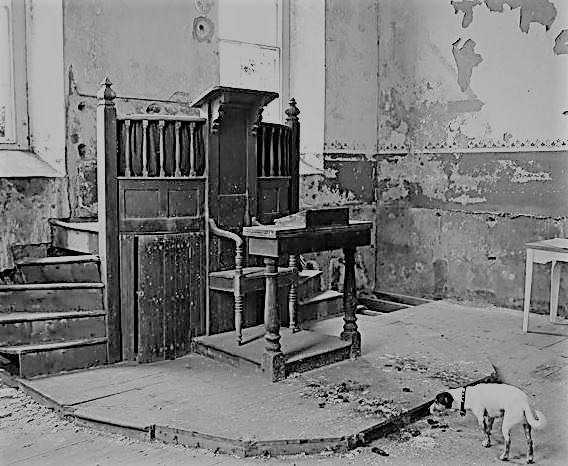
Oftentimes the 1928 BCP is identified as part of PECUSA’s downward slide by reason of eroding older penitential language. Some changes were indeed unfortunate but few consider the flexibility of rubrics which may compensate for much of what’s missing. Shouldn’t we be more careful about lumping, say, the 1928 BCP together with its 1979 counterpart? Or, for that matter, doing the same with any of the American BCPs? In time, I’d like to develop a robust defense of the 1928 and older American versions, but in this post I will begin to tackle a common complaint about the 1928, namely, its tendency to displace ‘sin’ out of the prayer book, starting with the Penitential Office.
The earlier version of the Penitential Office was called the Commination Service, and the comparison of the two is where critics usually get their disagreements. But, the 1928 BCP did not gut-out the Commination Service. Rather, the 1928, along with the 1892 revision, restored the heart (or liturgical part) of the 1662 service, renaming it the ‘Penitential Office’. Keep in mind the first American books, both the 1785 and 1789 versions, had entirely removed the Service. It wasn’t until the third revision of 1892 that the Commination Service, arguably the better part of the Service, found its way back into the American liturgy. The 1928 BCP simply retained this restoration without alteration. Of its history, Massey Shepherd sums,
The 1892 revision introduced this Office into the American book. It consists of the latter part [second half] of a ‘Commination’ service in the English book…. The proposed book of 1786 and the 1789 book had included only the [last] three prayers on pg. 62, to be said on Ash Wednesday at Morning Prayer after the Litany and immediately before the General Thanksgiving.
But, why did the American Compilers wholly remove the Commination Service? Curiously, the Preface of the American book cites the 1689 Liturgy which sought to assuage the scruples of other Protestants. The 1689 commission therefore fixed the foremost complaints, 1) removing the Mosaic curses (substituting it with the Beatitudes) 2) while retaining, without alteration, that portion of the Service known as the Penitential Devotions. Rather than rewrite the Mosaic denunciations (and exhortation) as the 1689 Commission did, the compilers in 1892 dropped controverted parts, keeping the final section called the Devotions. Arguably, this was that portion of the Service which was best received on all sides. If the denunciations were removed due to a ‘liberal’ bias, it was on the part of moderate Presbyterians rather than by Victorian Anglicans with a particular ax-to-grind.
Indeed, the common complaint with the Denunciations tended to be directed against the ‘Amen’ rather than the the curses themselves. Critics decried the ‘Amen’, or ‘so be it’, as cursing themselves or neighbors in their responses. Wheatly observes:

The removal of the Exhortation might have followed a likewise scruple for the sake of dissenting Protestants who frowned upon the season of Lent. Their main worry was that Lent superstitiously treated repentance, confining Godly sorrow to a few weeks rather than daily basis. Another fear might be the return of related Papist customs like Ashing. Interestingly, Bucer advised the alteration of the Service’s subtitle, “to be used diverse times of the year”. Nonetheless, these suspicions continue to be frequent among other non-establishment Protestants. For example, the congregationalist minister, Rev. Charles Davis, skirts around the same suspicions in his book, Prayer Book Difficulties Explained:

The American Revolution provided circumstances to reconsider the Liturgy with high hopes about restoring Primitive Discipline now that obstruction from either Parliament or system of Patronage was dispensed. Perhaps much of this involved an optimism about churchmen finally escaping the ‘rage of Party’? Anyhow, the giddy expectations of the Revolution for the improvement of Discipline very likely, in the eyes of men like Smith or White, left the keeping of a Commination Service superfluous. This could be construed from Wheatly’s comments suggesting the temporary nature of the Service:

Arguably, it’s hard to blame the American 1928 Committee of crypto-liberalism when; 1) the American omission of the Service dates back to the Revolution, well-before the rise of early 20th-century liberal catholicism, comprehending long-disputed points from the non-episcopal side of Protestantism; 2) the rationale of Protestant Episcopalians immediately upon the Revolution was the restoring of Primitive Discipline (thus dispensing with an inferior office, aka. The Commination Service); and, 3) if anything, the 1928 committee, in agreement with the 1892 revisers, retained that part of the Service most esteemed and fit for ‘diverse times of the year’.
Given this rationale, the 1892, and with it the 1928 BCP, might be commended for altering the 1662 rubric which read, “and at other times as the Ordinary shall appoint” to “the Office may be read at other times, at the discretion of the Minister“. Obviously, shifting discretion from the Ordinary to Minister makes frequent use of the Office more likely– possibly a low-church concession. Nonetheless, the rubric is quite powerful, allowing the reading of the Service independently or alongside any other Office, thereby ‘beefing up’ of the penitential character of the 1928 Prayer Book. Of course, some days are more timely than others for this Use. Archbishop Grindal recommended, for example:

This year our UE Chapel is trying to move in a churchly direction, and perhaps Grindal’s advises for using the Service shall be observed. They also tend to be days important to preparing for greater Sacrament Seasons (like Easter, Pentecost, and Christmas). These Seasons are not necessarily times all Anglicans bother to austerely observe, or even jealously stick to the Offices of the Prayer Book, so an increased familiarity with the Penitential Office wouldn’t hurt. A recent FB post by the Presiding Bishop of the UECNA, Peter Robinson, tells more of UE practices, in this case, for Ash Wednesday.
On a final note, before dismissing the 1928 BCP as part of liberal revision, the longer history of low-church grievances, especially as treated at various conferences to comprehend, should be considered– the substance of these being legitimately descended from the Reformation or Restoration-era rather than recent Modernism. Therefore, the book as a whole, and how its offices work together, with special attention to certain wide-ranging rubrics, ought to be assessed before casting judgement on any particular part. Altogether, I believe critics of the 1928 BCP will find it remains a more low-church book than typically imagined.
This article was cross-posted at Anglican Rose.

[…] This essay was also posted at River Thames Beach Party […]